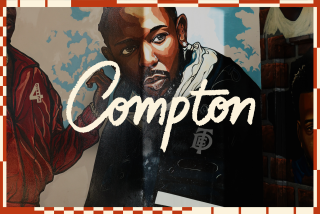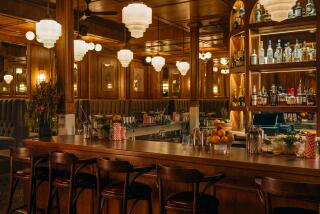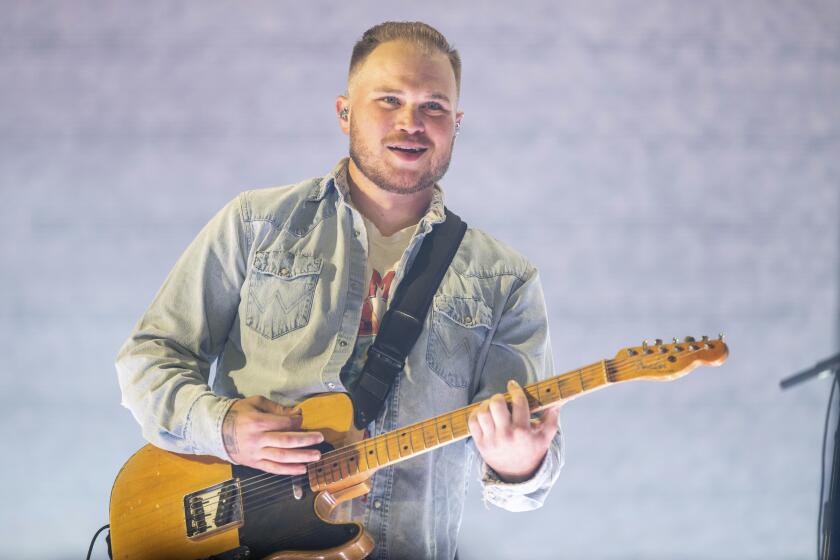Raise a Glass for Al’s Bar--It’s Last Call
Around 1:30 a.m. last Sunday morning, Toast Boyd took what may have been the last stage dive at Al’s Bar. Boyd, the music booker for the seminal West Coast punk club, had jumped on stage to play bass with the Warlocks, a garage rock band whose bassist hadn’t shown up. She didn’t know the song, so she faked it, then departed the stage in classic Al’s Bar style--with a flying leap.
“It’s tragic that Al’s is closing,” Boyd said later. “It has always had more creative bands and a more creative atmosphere than any other place in Los Angeles.”
With the sale of the American Hotel, which includes Al’s Bar and three other ground-floor bus-inesses at the corner of Hewitt Street and Traction Avenue downtown, to Magnum Properties earlier this month, the future of the legendary dive is in question. Marc Kreisel, who has owned Al’s since 1979, did not want to be interviewed for this story, but is hoping to reclaim the lease on the bar.
Most people involved with the club, however, think it’s over for Al’s Bar as we know it. If this is the case, Al’s has ended its reign as both the West Coast’s oldest punk club and the downtown artists’ district’s central meeting place.
More than just a haven for alternative music, Al’s was also a neighborhood bar frequented by artists, musicians, writers and the odd policeman or downtown working stiff.
“It was like a town hall or a town square,” said Scott Sterling, a former Al’s Bar bartender. Now a music booker at the Silver Lake Lounge in Silver Lake, Sterling said he tries to emulate Al’s Bar’s dedication to the bands rather than the bucks.
Al’s was a training ground to many hundreds of bands. Some, like Beck, Sonic Youth, the Red Hot Chili Peppers, the Fall, the Residents and the Misfits, went on to bigger fame. The Jesus Lizard is rumored to have a clause in its record label contract to the effect that no matter how successful the band becomes, it can always play shows at Al’s (which could legally accommodate up to 185 people).
Local bands, such as 400 Blows, Tadpole and Blues Experiment, maintained a Southern California stardom thanks to Al’s, and reinforced the venue’s stature as a clubhouse for progressive musicians working largely outside of the rock mainstream.
“The people who hung out at Al’s were the true artists of rock ‘n’ roll,” said Tia Sprocket, drummer for the band Die Fast. She said she was not dismayed that the sound system was under par when her band played Al’s recently. “People rocked out and destroyed the system every night. The whole place was like a moving train--it had a great soul, and you don’t find that in clubs with perfect sound systems.”
As L.A.’s closest kin to New York’s famed rock haunt CBGB, Al’s was unwaveringly dedicated to rock music and the rebel artist lifestyle.
Contributing to the anarchic atmosphere were band-sticker and graffiti decor and a chronically abused foosball table and pool table. The mood was enhanced when patrons enjoyed 32-ounce beers for $5 and enthusiastically disregarded indoor smoking laws.
“Tip or die” was the bar’s motto, shining in neon amid silk-screened posters for bands with names like Clovenhoof, the Eyeliners and Slack Babbath. And while many L.A. bands got their start at Al’s, the bar never encouraged music business executives to consider it a poaching territory.
In fact, when record-label employees called and asked to be comped the $5 admission, they would be instructed to tell the doorman they were on the “industry list.” They would arrive at the bar to learn that the “industry list” meant the cover was raised to $10.
Though Al’s Bar may open again, it is doubtful it will be the same club where bands like the Imperial Butt Wizards can set fire to the stage, as they once did--well, more than once. Magnum Properties owner Michael Meraz said he has set the rent at “around $4,000,” which is considerably higher than what Al’s Bar originator Kreisel was paying. And even if Kreisel or someone else ponies up the cash to keep it a rock club, they can’t stop Magnum from gentrifying the bar’s grungy, graffitied exterior, which some bar regulars say would change its character.
Kreisel, a downtown artist and entrepreneur, opened Al’s as a performance space in 1979. He reportedly bought the business from the eponymous Al, who previously ran the place as a truck stop cafe. “It was the only place downtown created by artists for artists to hang out in,” said Jack Marquette, who helped Kreisel book acts at Al’s in the early ‘80s. “We were always looking for the unknown, unsigned, underground talent. Like when I booked these three bands from Seattle that no one had ever heard of--Nirvana, Mudhoney and ... I forget the third one.”
Though theater continued to be part of the fare at Al’s, music soon took center stage. Al’s became known as one of the only L.A. venues that would book--and actually pay--obscure touring bands and fledgling local groups.
Al’s distinctive, if malodorous, decor attracted television and film crews seeking a gritty, punk atmosphere. Coolio, Bad Religion and Pennywise have filmed music videos at Al’s. And while celebrities could “keep it real” by dropping into Al’s--Chloe Sevigny, Steve Buscemi, Tommy Lee, Sean Penn and Pee-wee Herman were known to show up--”the ultra-hip always stayed away,” said Gus Hudson, a frequent patron, paying the bar the ultimate L.A. compliment.
“The legendary status of the bar really sunk in for me last week when someone called me wanting to get directions,” said Stay-C Little, an Al’s bartender of 11 years who met her future husband while on duty. “He said he called the operator for the number of Al’s Bar, and the operator said, ‘Did you hear it’s closing?’ The guy asked her how she knew, and the operator said, ‘Oh, I know the bar. I used to play there 20 years ago when I was in a band.’ ”
More to Read
The biggest entertainment stories
Get our big stories about Hollywood, film, television, music, arts, culture and more right in your inbox as soon as they publish.
You may occasionally receive promotional content from the Los Angeles Times.










